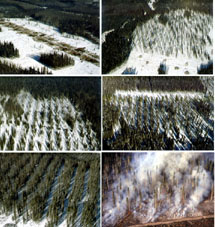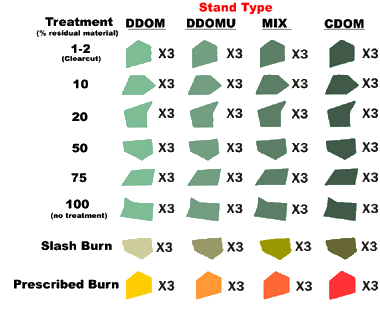The heart of EMEND is a fully replicated 4×8 factorial experiment with treatments applied to 10-hectare compartments, a size within the lower limit of the standard operational block size. Four forest cover-types, representing an undisturbed boreal mixedwood successional chronosequence, structure the first factor. Stands representing each cover-type were chosen to minimize variance in tree age, stand structure and volume.
Stand types (first experimental factor):
- canopy >70% deciduous (broadleaf) trees (primarily trembling aspen);
- canopy >70% broadleaf with a conifer (primarily white spruce) understory;
- mixed-wood stands with 40-60% conifer and broadleaf cover in the canopy; and
- canopy >70% conifer.
The second factor includes five harvest treatments (green tree retention = 2%, 10%, 20%, 50% and 75% of original stand volume), one partial harvest and prescribed burn treatment (10% retention with prescribed slash burns) and two kinds of controls – uncut compartments and compartments burned with prescribed ground fires (see Figure 1).
Harvest and Fire Treatments (second experimental factor):
- 2% green-tree retention (clearcut),
- 10% green-tree retention,
- 20% green-tree retention,
- 50% green-tree retention,
- 75% green-tree retention,
- 100% green-tree retention (uncut control),
- prescribed burns on unharvested stands
- 10% harvest with prescribed burn
 Each cover-type by treatment combination is replicated 3 times over the 1000-ha experiment. Treatments are generally blocked within relatively homogeneous stands that constitute the replicates.
Each cover-type by treatment combination is replicated 3 times over the 1000-ha experiment. Treatments are generally blocked within relatively homogeneous stands that constitute the replicates.
Whole compartment burns are the appropriate controls against which to judge the immediate effects of retention harvests and slash burns. These comparisons are essential in evaluating how closely treatments emulate natural disturbance processes. The uncut compartments are controls against which to judge the recovery of compartments to original conditions and to evaluate the claim that retention harvests will ‘life-boat’ sensitive species over this anthropogenic disturbance. Comparison to uncut compartments may reveal if any species from a range of indicator groups are threatened by the truncation of stand age distribution implicit in a harvest rotation and if residuals are “old-growth” islands that are effective sources for colonists.
The inclusion of two uncut patches (0.20-ha and 0.46-ha) per compartment along with distributed retention will allow assessment of the relative advantages of distributed and aggregated retention.

Figure 1: Harvest residual and burn treatments across the four stand types (cover type) at EMEND. Each 10 hectare treatment x cover type combination is replicated 3 times within each stand type.
Given the size of the experiment (100 compartments, >1000 ha) and its already-coarse ability to estimate variances in response variables, we exclude additional driving variables. Nonetheless, study of other response variables, through embedded, focused experiments, are essential (see Research Section). For example, effects of variation in coarse woody material might be analyzed with a regression approach, using data about mean natural variation between stand types and treatments or, for some questions, data reflecting within-compartment variation.
